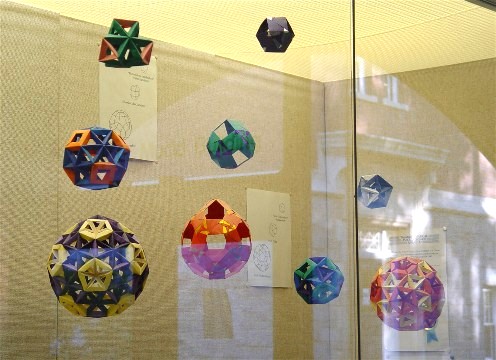Click on the first picture below to see a larger version.
Click here to see an explanation of the types of solids modeled here.
These are pictures of an origami display that I installed in the Amherst College Mathematics and Computer Science Department in 1995.
The explanations linked below are written for a non-mathematical audience and contain further photos and diagrams. These links also contain results of interest to students and practitioners of mathematics. I encourage all visitors to browse further.
The models here are examples of modular origami, in which a number of separately folded pieces, called units or modules, are folded without cutting from individual squares (or other polygons) of paper and assembled into complex forms without adhesives. In the interest of full disclosure, I should confess that I cheated and used a little glue in one phase of the assembly of the purple and yellow model in the lower righthand corner of the window. But other than that, this exhibit is totally adhesive free.
Click on the first picture below to see a larger version.
Click here to see an explanation of the types of solids modeled here.
(Unlike the rest of the exhibit pictures here, the photo below was taken with a digital camera eight years after the initial installation. The two center models with open squares and pentagons have been visibly distorted by gravity over the years.)

Click here to see which solids are represented by the hanging models.
Click here to see an explanation of duals of regular solids.
Click here to see an explanation of symmetry groups of regular solids.
Click here to see some further facts about symmetries and embeddings of regular solids.
Click here to see models from the original exhibit that were subsequently removed.
Click here to see some other origami and non-origami models I've made.
To see some symmetry groups in two dimensions, check out the University of Minnesota Geometry Center program Kali, which lets you draw patterns with various symmetries.
To see a program in development that allows you to look at four-dimensional polytopes, check out Gordon Kindlmann's Peek.
To see pictures of real-life symmetries (both two- and three-dimensional), look at Dror Bar-Natan's Image Gallery. His section on tilings has more cool symmetry links.
For information about the mathematics of origami and an excellent collection of online and offline references, go to Thomas Hull's Origami Mathematics Page. Unlike this page, which uses origami models to illustrate geometric principles, Hull's origami math page deals primarily with the mathematical underpinnings of origami itself.
Instructions for making most of the modules used in this display can be found in Tomoko Fuse's masterwork Unit Origami: Multidimensional Transformations.
Scott Kim has two lovely inversions of the word "origami": an animated mirror-symmetric inversion and a bilingual English/Japanese figure.
For more information on polyhedra, wickedly cool artwork, and lots of great links, visit George W. Hart's Pavilion of Polyhedreality.